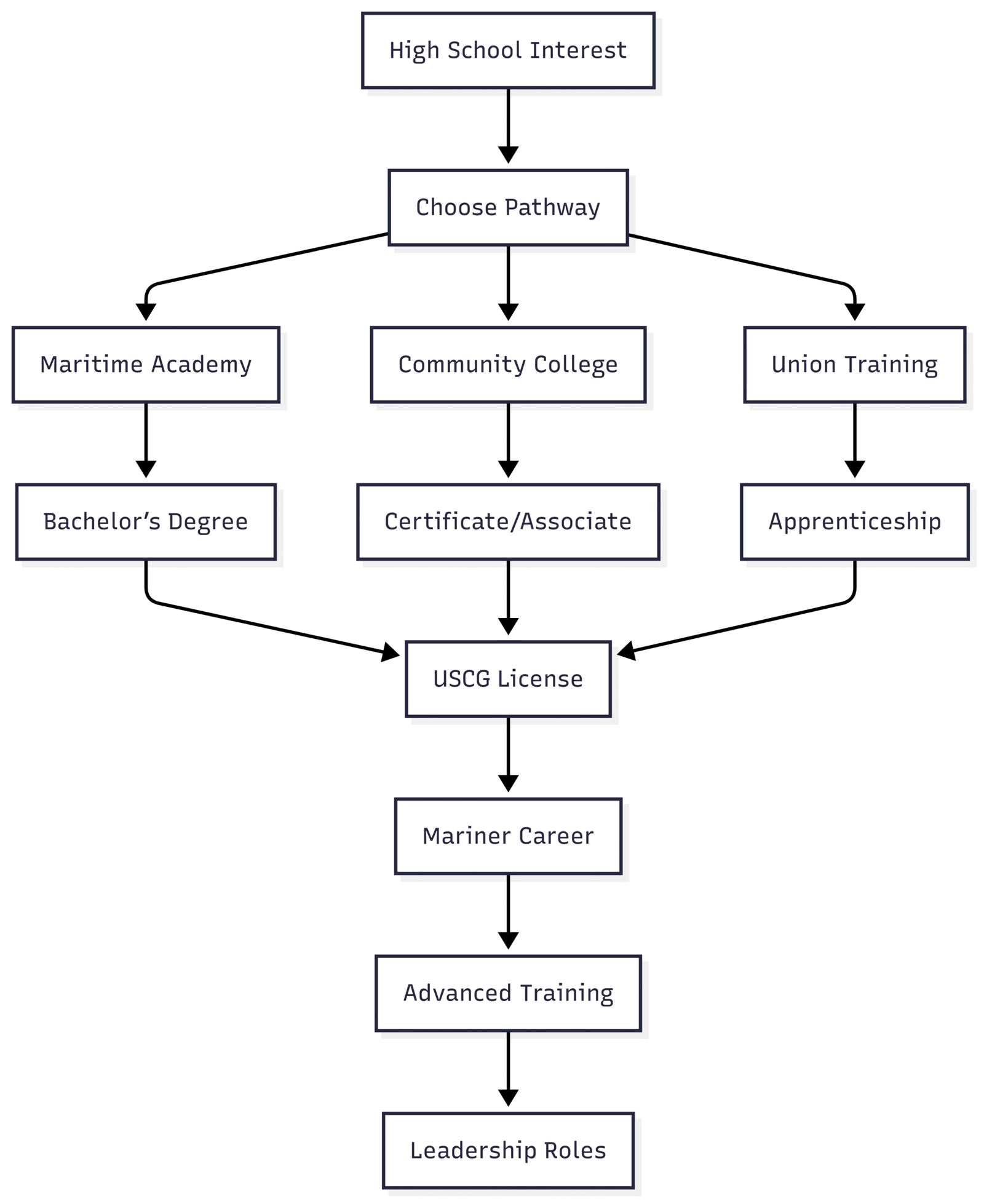Maritime Education in the USA: Preparing the Next Generation of Seafarers and Mariners
The maritime industry underpins global commerce, with commercial ships transporting approximately 90% of the world’s trade. As demand for skilled mariners grows, maritime education in the United States plays a pivotal role in equipping the next generation to navigate the complexities of modern shipping. This comprehensive guide explores the state of maritime and marine education, highlighting key institutions, educational pathways, certifications, technological advancements, and initiatives addressing workforce challenges. It provides a detailed roadmap for aspiring seafarers and insights into how the U.S. is shaping a robust maritime future.
The Importance of Maritime Education
Maritime education equips individuals with the skills to operate and manage commercial vessels, ensuring the safe and efficient transport of goods across oceans. It encompasses disciplines like navigation, marine engineering, logistics, maritime law, and environmental science. With the industry facing challenges such as mariner shortages, technological advancements, and the need for diversity, U.S. institutions are adapting to prepare graduates for both current demands and future innovations. The U.S. Maritime Administration (MARAD) emphasizes that a skilled workforce is critical for national security, economic stability, and global trade.
Key Maritime Institutions in the USA
The U.S. hosts several prestigious maritime academies and institutions, each offering specialized programs tailored to industry needs. Below is an overview of the leading institutions, their programs, and unique features.
United States Merchant Marine Academy (USMMA) – Kings Point, New York
The USMMA, or Kings Point, is a federal service academy renowned for its rigorous curriculum. Students earn a Bachelor of Science degree, a U.S. Coast Guard (USCG) merchant mariner license, and a commission in the U.S. Armed Forces reserves. The program blends academic coursework with hands-on sea training aboard commercial or training vessels, preparing graduates for officer roles in the maritime industry.
- Programs: Marine transportation, marine engineering systems, maritime logistics, and supply chain management.
- Key Feature: Mandatory Sea Year, where students gain practical experience on active vessels.
- Tuition: Tuition-free for U.S. citizens (in exchange for service obligation).
- Graduates per Year: Approximately 200.
Massachusetts Maritime Academy (MMA) – Buzzards Bay, Massachusetts
MMA offers undergraduate and graduate programs with a focus on practical experience through its Sea Term, a training voyage on the academy’s ship, TS Kennedy. The curriculum emphasizes marine engineering, marine transportation, and emergency management.
- Programs: Marine engineering, marine transportation, international maritime business, emergency management.
- Key Feature: Sea Term, a two-month training cruise.
- Tuition: Approximately $10,000/year (in-state), $28,000/year (out-of-state).
- Graduates per Year: Approximately 300.
Maine Maritime Academy (MMA) – Castine, Maine
Located on the coast, Maine Maritime Academy provides programs in engineering, management, and transportation, with a strong emphasis on hands-on learning. Its training ship, State of Maine, supports practical training.
- Programs: Marine engineering technology, marine systems engineering, international business and logistics.
- Key Feature: Co-operative education programs with industry partners.
- Tuition: Approximately $14,000/year (in-state), $29,000/year (out-of-state).
- Graduates per Year: Approximately 200.
California State University Maritime Academy (Cal Maritime) – Vallejo, California
The only West Coast maritime academy, Cal Maritime offers small class sizes and strong industry connections, facilitating internships and job placements. Its proximity to the Pacific enhances training opportunities.
- Programs: Marine transportation, marine engineering technology, global studies, maritime policy.
- Key Feature: Training ship Golden Bear for hands-on experience.
- Tuition: Approximately $7,000/year (in-state), $18,000/year (out-of-state).
- Graduates per Year: Approximately 250.
Texas A&M University at Galveston (TAMUG) – Galveston, Texas
TAMUG combines maritime and marine science programs, leveraging its Gulf of Mexico location for unique research and training. Programs range from marine biology to maritime administration.
- Programs: Marine engineering technology, maritime administration, marine biology.
- Key Feature: Research opportunities in marine environments.
- Tuition: Approximately $11,000/year (in-state), $25,000/year (out-of-state).
- Graduates per Year: Approximately 400.
Other Institutions
- Community Colleges: Offer associate degrees and certificates in maritime technology, welding, and logistics. Examples include Seattle Central College and Great Lakes Maritime Academy.
- Union-Sponsored Programs: The Seafarers International Union (SIU) operates the Paul Hall Center, providing apprenticeships and training for unlicensed mariners. Cost: Often free with union membership.
- Specialized Training Centers: The Maritime Institute of Technology and Graduate Studies (MITAGS) offers advanced courses in ship handling, safety, and cybersecurity. Prices vary, typically $500-$2,000 per course.
| Institution | Location | Key Programs | Tuition (Annual, Approx.) | Unique Feature |
|---|---|---|---|---|
| USMMA | Kings Point, NY | Marine transportation, engineering | Tuition-free (service obligation) | Sea Year |
| Massachusetts Maritime | Buzzards Bay, MA | Marine engineering, transportation | $10,000 (in-state), $28,000 (out-of-state) | Sea Term |
| Maine Maritime | Castine, ME | Engineering, logistics | $14,000 (in-state), $29,000 (out-of-state) | Co-op programs |
| Cal Maritime | Vallejo, CA | Marine transportation, global studies | $7,000 (in-state), $18,000 (out-of-state) | Training ship |
| TAMUG | Galveston, TX | Marine biology, maritime administration | $11,000 (in-state), $25,000 (out-of-state) | Gulf research |
Educational Pathways and Certifications
Maritime education offers diverse pathways to suit various career goals, combining academic rigor with practical training.
Bachelor’s Degrees
Most maritime academies offer Bachelor of Science degrees in fields like:
- Marine Transportation: Focuses on navigation, ship operations, and maritime law.
- Marine Engineering: Covers propulsion systems, maintenance, and vessel design.
- Logistics and Supply Chain: Prepares students for shoreside roles in port management and shipping logistics.
These programs typically take four years and include 6-12 months of sea time. Graduates are eligible for officer positions.
U.S. Coast Guard Licenses
A USCG license is mandatory for officer roles on commercial vessels. Types include:
- Deck Officer: Manages navigation and cargo operations.
- Engineering Officer: Oversees engine room operations.
- Pilot: Specializes in guiding vessels in specific waterways.
Requirements: 360 days of sea time, written and practical exams, medical fitness. Cost: Exam fees approximately $200-$500.
Graduate Programs
Master’s degrees in maritime law, business, or engineering are offered for career advancement. Examples:
- Maritime Law (Tulane University): Focuses on legal frameworks, cost ~$30,000/year.
- Maritime Business (TAMUG): Prepares for executive roles, cost ~$15,000/year.
Certificates and Short Courses
Short courses enhance skills in:
- Ship Handling: Simulators for navigation, ~$1,000.
- Maritime Safety: STCW-compliant courses, ~$500-$2,000.
- Cybersecurity: Emerging focus, ~$1,500.
These are ideal for professionals meeting continuing education requirements.
Industry Challenges and Solutions
The maritime industry faces several challenges, with education playing a critical role in addressing them.
Mariner Shortage
The U.S. faces a shortage of qualified mariners, with only 1,800 licensed officers graduating annually against a need for thousands more to support military and commercial fleets. MARAD estimates a gap of 1,800 mariners for sealift operations alone.
Solutions:
- Outreach: MARAD’s Maritime Primary & Secondary Educational Coalition (MPSEC) engages K-12 students through career fairs and school programs.
- Military to Mariner (M2M): Transitions veterans to maritime roles, waiving certain licensing fees (saves ~$200-$500).
- Apprenticeships: SIU’s Paul Hall Center trains 300-500 unlicensed mariners annually, fully funded.
Diversity and Inclusion
The industry is historically male-dominated, with women comprising less than 10% of mariners. Academies are increasing scholarships and outreach to underrepresented groups.
Initiatives:
- USMMA’s diversity programs offer mentorship and scholarships (~$5,000-$10,000 annually).
- Women in Maritime Operations (WIMOs) provides networking and training.
Technological Advancements
Automation, cybersecurity, and green technologies (e.g., LNG-powered ships) require updated curricula. Academies invest in simulators ($100,000-$1M each) and courses on autonomous navigation.
Example Curriculum Updates:
- Cybersecurity for maritime systems.
- Green propulsion technologies.
- Data analytics for logistics.

Federal and Legislative Support
MARAD drives maritime education through:
- Centers of Excellence (CoE): Networks 50+ institutions for curriculum development and job placement.
- K-12 Outreach: Engages 10,000+ students annually through career days.
- NSMV Program: Five National Security Multi-Mission Vessels (NSMVs) built for training at state academies. Each vessel (e.g., for Cal Maritime) costs ~$300M, accommodates 600 cadets, and includes advanced simulators and hospital facilities.
The SHIPS for America Act proposes $12B in investments to expand shipbuilding and training, potentially creating 20,000 jobs.
National Security Multi-Mission Vessel (NSMV) Program
The NSMV program, managed by TOTE Services and Hanwha Philly Shipyard, replaces aging training vessels. Key features:
- Vessels: Empire State (SUNY), Patriot State (MMA), and three others in progress.
- Specifications: 525 feet long, 17 knots speed, 600 cadet capacity, hospital, helicopter pad.
- Cost: ~$300M per vessel.
- Purpose: Training and disaster relief support.
The Vessel Construction Manager (VCM) model accelerates delivery, saving ~$50M per vessel compared to traditional methods.
Career Opportunities and Benefits
Maritime careers offer competitive salaries and global opportunities:
- Deck Officer: $80,000-$150,000/year.
- Marine Engineer: $90,000-$160,000/year.
- Port Manager: $70,000-$120,000/year.
Benefits include travel, comprehensive health plans, and early retirement options after 20-25 years.
Getting Started
Aspiring mariners can start by:
- Researching Institutions: Use MPSEC’s database of 500+ schools.
- Applying to Academies: Competitive, requires strong academics and physical fitness.
- Exploring M2M: Veterans contact MARAD at careersafloat@dot.gov.
- Joining Unions: SIU offers free training with membership.
For inquiries, contact MARAD’s Office of Maritime Labor & Training: (202) 493-0029.
Conclusion
Maritime education in the U.S. is a cornerstone of the global shipping industry, producing skilled seafarers through robust programs at federal and state academies, community colleges, and union schools. With initiatives like NSMV and SHIPS for America, alongside MARAD’s support, the industry is poised to address shortages, embrace technology, and foster diversity. Aspiring mariners have diverse pathways to rewarding careers, ensuring the U.S. remains a leader in maritime innovation.
Happy Boating!
Share Maritime Education in the USA: Preparing the Next Generation of Seafarers and Mariners with your friends and leave a comment below with your thoughts.
Read Boat Illustration Png 4K HD Wallpapers until we meet in the next article.






